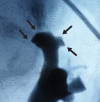Long-Term Passive Ureteral Dilatation with Double-J Stent: Possibly an Effective Treatment for Recurrent Renal Colic Caused by Papillary Renal Necrosis
- PMID: 33457720
- PMCID: PMC7803271
- DOI: 10.1089/cren.2020.0141
Long-Term Passive Ureteral Dilatation with Double-J Stent: Possibly an Effective Treatment for Recurrent Renal Colic Caused by Papillary Renal Necrosis
Abstract
Background: An uncommon cause of recurrent renal colic is mucous tissue passage secondary to renal papillae necrosis. Because of its low prevalence, the correct management of recurrent obstructive uropathy produced by renal papillary necrosis (RPN) is not well defined. Case Presentation: We present a case of recurrent renal colic associated with the expulsion of mucous tissue in a young woman's urine with a history of excessive consumption of nonsteroidal anti-inflammatory drugs (NSAIDs). The patient required multiple admissions to the emergency department because of recurrent episodes of renal colic. A retrograde pyelogram and histopathologic study of the expulsed tissue supported the diagnosis of RPN. The patient was managed with Double-J stents for 12 months, complete withdrawal of NSAIDs, and large volume intake of water. A satisfactory outcome was seen radiologically and endoscopically after treatment. The patient stopped experiencing new renal colic episodes because of the passive ureteral dilatation despite still presenting the mucous tissue expulsion in the urine. Conclusions: Passive ureteral dilatation with Double-J stents could possibly be an effective treatment for patients with recurrent renal colic secondary to persistent renal papillae necrosis.
Keywords: infection/inflammation; obstruction; stents; ureteroscopy; ureteroscopy instrumentation.
Copyright 2020, Mary Ann Liebert, Inc., publishers.
Conflict of interest statement
No competing financial interests exist.
Figures




References
Publication types
LinkOut - more resources
Full Text Sources
